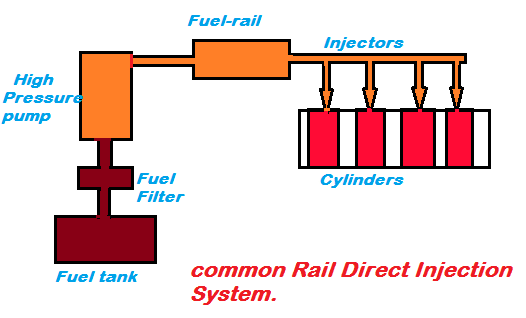Common rail direct injection system (CRDI):
Common rail direct injection system is mostly used in modern diesel engines. In this type of injection system, the fuel is supplied to the injectors with the required pressure and further supplied to the cylinders for the combustion process.
By using a common rail direct injection system the required pressure can be obtained in all the injectors and the same energy obtained from all the cylinders. this process increases the efficiency, decreases the fuel supply, etc.
Working of a Common Rail Direct Injection System:
In common rail direct injection system, the fuel is collected from the tank and further supplied into the pressure pump through the fuel filters, the pressure pump used to increases the pressure of the fuel and supplied to the fuel rail, in fuel rail section the pressurized fuel is supplied into the injectors with same quantity and same pressure in all injectors and further the fuel in the injectors is supplied into the cylinders for combustion process.
Construction of a CRDI:
CRDI consist of different parts like a pump, fuel rail, injectors, etc. the fuel tank is connected to the high-pressure pump, which increases the pressure of the fuel and this pump is connected to the fuel rail, this fuel rail is used to maintain the required pressure and this is connected to the injectors. with the help of fuel rail, the supply of pressurized fuel is maintained equally and these injectors are connected to the cylinders for the further combustion process.
Main parts of common rail fuel injectors:
Pressure Pump:
This is the main part of the system, it is used to increase the pressure of the fuel and supplied to the fuel rail.
Fuel-Rail:
This is used to collect the high-pressure fuel and helps to supply the same quality and pressurized fuel into the injectors.
Injectors:
Injectors used to maintain the required pressure and the pressurized fuel is supplied into the cylinders for the combustion chamber.



